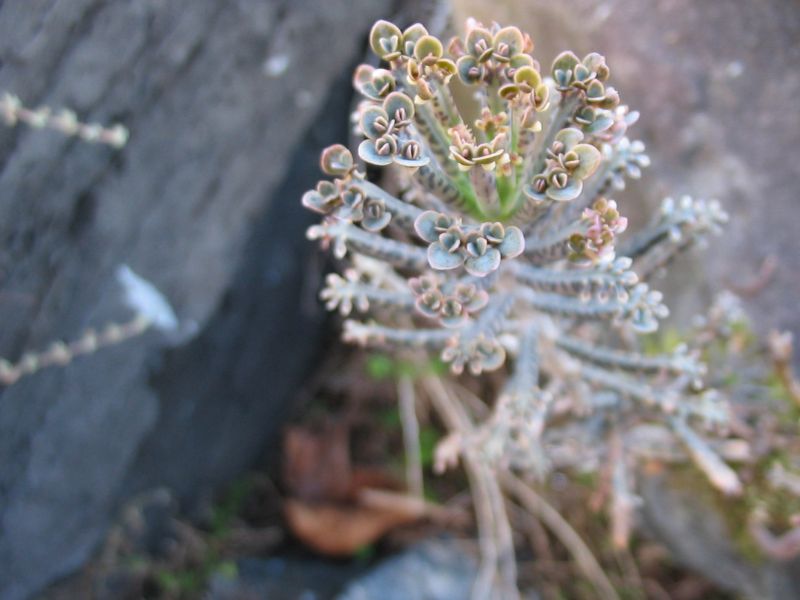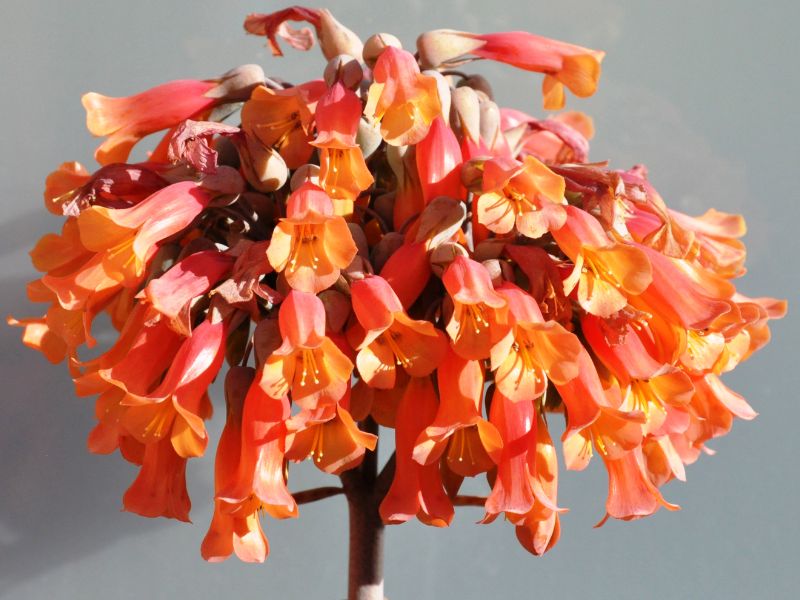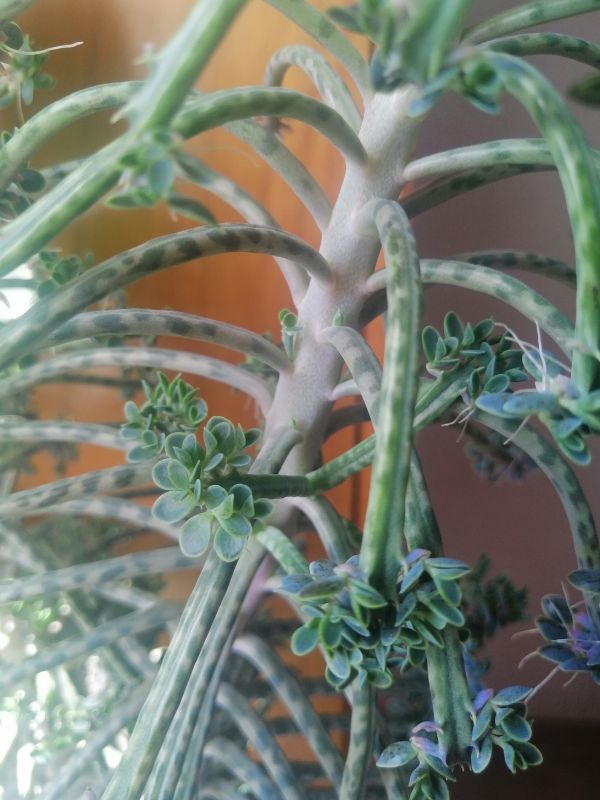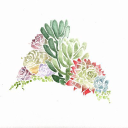The Chandelier Plant (Kalanchoe delagoensis), also known as Devil’s Backbone, Mother-In-Law-Plant, or Mother of Millions, is a fascinating succulent belonging to the Crassulaceae family and the Kalanchoe genus. Native to Madagascar, this perennial plant thrives in arid conditions, making it a favorite among gardeners in drought-prone areas.
Synonymous with Bryophyllum delagoense, the Chandelier Plant is recognized for its adaptability and ability to endure challenging environments. Its resilience and unique appearance have earned it a place in many gardens, where it serves as both a striking ornamental and a low-maintenance addition.
| Common name | Chandelier Plant, Devil’s Backbone, Kalanchoe, Mother-In-Law-Plant, Mother of Millons |
| Botanical name | Kalanchoe delagoensis |
| Family | Crassulaceae, Crassulaceae |
| Genus | Kalanchoe |
| Species | delagoensis, delagoensis |
| Origin | Madagascar, Madagascar |
| Life cycle | Perennial |
| Plant type | Herbaceous Perennial |
| Hardiness zone | 10, 11 |
| Sunlight | Full Sun |
| Maintenance | Medium |
| Soil condition | High Organic Matter |
| Drainage | Well-Drained |
| Growth rate | Medium |
| Flowering period | Winter |
| Flower color | Gold, Yellow |
| Leaf color | Gray, Silver |
| Stem color | Green |
| Fruit type | Follicle |
| Flower benefit | Showy |
| Garden style | Drought Tolerant Garden |
| Uses | Container |
I. Appearance and Characteristics
Kalanchoe delagoensis, formerly known as Bryophyllum delagoense and commonly called mother of millions or chandelier plant, is a succulent plant native to Madagascar. Like other members of Bryophyllum (now included in Kalanchoe), it is able to propagate vegetatively from plantlets that develop on its leaf margins.
It is a robust, completely bare, biennial or more or less perennial, succulent plant that reaches heights of between 0.2 and 2 meters. The upright stems are simple and round. The three-seated, seemingly opposite or alternate leaves are usually upright to straight when spread out.

They are slightly cylindrical, a little rutty on the top and reach a length of 1 to 13 centimeters with a diameter of 2 to 6 millimeters. The leaf blade narrowed at the base is reddish-green to gray-green with reddish brown spots. At the tip of the leaf margin there are two to nine small teeth on which there are numerous brood buds.
Inflorescences
The compact, multi-flowered inflorescences form thyrses 10 to 25 centimeters long. The slender flower stalk is between 6 and 20 millimeters long. The hermaphrodite flowers are hanging. The reddish to green and red-striped petals are fused together like a bell. The 2.5 to 6 millimeter long corolla tube ends in sharply pointed, triangular-lanceolate corolla lobes 5 to 10 millimeters long and 3.7 to 5.7 millimeters wide.
The stamens are attached below the center of the corolla tube and do not protrude beyond the tube. The 2 to 2.5 millimeters large anthers are egg-shaped. The nectar flakes, 0.7 to 2 centimeters long are half-round to square with a rounded tip. The oval-elongated carpel is 5.5 to 6.5 millimeters long. The stylus has a length of about 2 millimeters.
The upright follicles contain seeds with a diameter of 0.6 to 2.5 millimeters.

II. How to Grow and Care
Sunlight
Chandelier plants require full to partial sunlight; six hours or more is ideal. When growing this succulent outdoors, choose a planting location that receives morning sunshine but adequate protection from the harsh afternoon sun. This will ensure the plant gets enough light while preventing the foliage from burning. As a houseplant, place this plant near a bright window so it can get bright, indirect light.
Temperature and Humidity
Kalanchoe Delagoensis thrives in warm temperatures, ideally in tropical climates. For outdoor growing, they do best in USDA zones 10 and 11 and cannot handle temperatures below 50 degrees Fahrenheit. As for humidity, the chandelier plant enjoys medium to very low humidity. It does not do well in high humidity.
Watering
As a succulent, chandelier plants have minimal watering needs. They prefer dry conditions and do best when the soil is allowed to dry out between waterings. Once the soil is dry, water thoroughly and allow all excess water to drain away from the pot.

Like other succulents in the Kalanchoe species, chandelier plants may go dormant during the summer months. During the plant’s dormancy period (marked by no active growth with the possibility of some wilting), withhold water longer than usual—up to two weeks.
Soil
These hardy plants are not very picky when it comes to soil types, as long as it is not heavy and wet. These plants thrive in sandy, loamy, well-draining soil. It is important that the soil is able to dry out, as wet or soggy soil can cause rot for these plants.
Fertilizing
To bolster chandelier plant’s growth and improve resilience, utilize a succulent-specific feed, sparingly applied every 2-4 weeks during its active growth phase in spring and summer. Less is more; avoid over-fertilization which can harm chandelier plant. During dormancy in fall and winter, reduce feeding to every other month, if at all. Dilute the fertilizer to half strength to prevent root burn and encourage steady, healthy growth without overwhelming the chandelier plant. Seasonal adjustments in fertilization ensure the chandelier plant receives optimal nutrients when it’s primed for absorption, aligning with its natural growth cycle.
Pruning
In order to keep their beautiful shape, some large succulent plants may need pruning. For example, in California, for echeveria planted in the garden, some redundant branches and branches that are too dense need to be cut off in spring and autumn. This depends on what you think and what the succulent plant is used for. Tools for pruning mainly include knife, scissors, and some medicines (such as sulfur powder).
In order to propagate new plants, we can also cut some leaves in spring and autumn for cutting. Stout stems with 5-6 leaves are often selected: cut it off with a knife, then smear the wound with sulfur powder, and plant it after the wound is healed. At this time, it is recommended to use a watering can to slightly wet the soil used for cutting.
Propagation
The plant earns its name ‘Mother of Millions’ because it is extremely easy to propagate. You can propagate the plantlets or take a cutting.
To propagate the plantlets, you will need well-draining, sandy soil and a small pot with drainage holes. Then follow these instructions:
- Once your plant has produced plantlets, choose a healthy, large plantlet you would like to propagate.
- Gently grasp the plantlet and twist until it pops off of the mother plant.
- Place the plantlet on top of moistened, sandy soil.
- Water the soil when it begins to dry out. Keep the plantlet in bright, indirect lighting.
- The plantlet will develop roots and begin to grow in a few weeks.
If you would like to propagate this plant with a cutting, you will need a small pot with drainage holes, sandy, well-draining soil, and a pair of sharp snips. Then follow these instructions:
- Select a portion of your plant that you would like to propagate. Ideally, it should be around 4 inches long.
- Snip above a set of leaves.
- Set the cutting aside and allow the cut end to callus over the course of a few days.
- Once a callus has formed, plant the cutting into moistened, well-draining soil.
- Keep the cutting in bright, indirect lighting. Water once the soil begins to dry.
- Roots should form in a few weeks.
Potting and Repotting

Chandelier plants do very well when kept in pots. It’s an effective way to enjoy these plants indoors, as well as control their spread outdoors. This plant does not often need to be repotted. Depending on how much it goes, you may only need to repot it once every year or two.
It is best to repot it in the spring or summer once the plant is done blooming, if the plant bloomed at all. When the plant’s growth seems stunted and there are roots poking out of the pot’s drainage holes, it is time to repot. Select a pot with drainage holes that is a couple of inches larger than its current pot. A terracotta pot works well, as it allows the soil to breathe and allows excess water to drain. Gently tip the plant on its side and slide it out of its current pot. Plant it in its new pot with new, well-draining soil.
Overwintering
When kept outdoors in a tropical climate, there is nothing that must be done to overwinter these plants. If you are keeping this plant in a region where temperatures drop below 50 degrees Fahrenheit during the winter, you will need to take this plant indoors.
Repotting
For chandelier plant, a vertical succulent, repot every two years to accommodate rapid growth. Best repotted in spring, use a pot that’s 20-30% larger to ensure space for root development. Provide a sandy, well-draining mix to prevent water-logging. After repotting, water sparingly and avoid direct sunlight for a week to foster recovery and encourage robust growth.
How to Get to Bloom

This plant produces clusters of bright orange flowers that resemble the dangling crystals of a chandelier. These flowers appear in the late winter to early spring when they are grown outdoors. When kept indoors, they almost never bloom.
To encourage blooming, be sure that the plant receives plenty of bright light but is protected from the harsh afternoon sun. You may also wish to give it some succulent fertilizer to ensure it has all the needed nutrients. Once the flowers fade, you can trim them off.
Common Problems
These hardy plants do not often contend with problems. However, under certain circumstances, some issues may present themselves.
Wilting, Soggy Stems
Because Kalanchoe Delagoensis prefers dry conditions, overwatering can easily lead to soggy stems. Eventually, this can cause rot in the plant. If you suspect that your plant is overwatered, stop watering until the soil is dry. If you see signs of wilting, you may wish to change the soil to remove the moisture quickly. If rot is present, cut away the infected parts and replant the plant in dry soil.
Dry, Brown, Curling Leaves
This is a sign of the plant getting too much sun or too little water. If the plant is receiving full sun, it may be getting burned. Move the plant to an area where it will receive bright, indirect light and protection from direct sunlight. If the soil is overly dry, be sure to water it thoroughly and allow all excess water to drain away from the pot.
III. Uses and Benefits

The chandelier plant is good for xeriscaping or as a houseplant in drought-tolerant gardens. It is also kept for its ornamental value with orange to scarlet flowers. The chandelier plant prefers to be planted alone, but companion plants may of kalanchoe plants include cactus, aloe, and paddle plants.
Find Where to Buy the Best Chandelier Plant (Kalanchoe delagoensis)














Leave a Reply